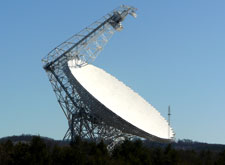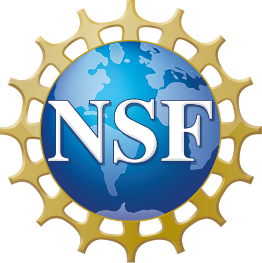Green Bank Software Development
Internal Software Wiki
Green Bank Telescope Observer's Interface
The Astronomer's Integrated Desktop (astrid) is a single, unified workspace that incorporates, but does not replace, the suite of applications that can be used with the Green Bank Telescope. astrid currently provides astronomers with easy access to an observation management application, a near-real-time data display, and a GBT status display among other things. astrid is an application manager, which means that all of the underlying science is taken care of by the individual applications.
The Observing with the Green Bank Telescope Guide provides essential information detailing the software, including astrid, for conducting observations with the Green Bank Telescope.
Green Bank Telescope Data Analysis
The primary tool for reduction and analysis of GBT spectral line data is GBTIDL. GBTIDL consists of a set of straightforward, yet flexible calibration, averaging, and analysis procedures (the "GUIDE layer") modeled after the UniPOPS and CLASS data reduction philosophies, a customized plotter with many built-in visualization features, and Data I/O and toolbox functionality that can be used for more advanced tasks. GBTIDL works with pointed spectroscopy observations, and currently has only limited support for imaging and continuum observations. GBTIDL is the preferred package for reducing pointed spectroscopy data.
GBT spectral line imaging data can also be reduced and analyzed in AIPS++, the Astronomical Information Processing System. A customized application has been developed within the AIPS++ system to handle single-dish radio spectral data, called DISH. DISH includes both a graphical and a command line interface. AIPS++ may also be used to reduce GBT continuum single dish images. DISH and AIPS++ are the preferred packages for reducing on-the-fly map data.
A continuum imaging package called OBIT is under development. Please contact Bill Cotton for details and status of OBIT. For general continuum data reduction, users can run GFM, the DCR tool (which handles pointing, focusing, and the like) or the AIPS++ imager application (an alternative to OBIT for continuum imaging).
Also, the classic AIPS, Astronomical Image Processing System, program is supported in Green Bank on the Linux platform only. AIPS is a software package for calibration, data analysis, image display, plotting, and a variety of ancillary tasks on Astronomical Data. It comes from the National Radio Astronomy Observatory. It is primarily for Radio Astronomy. There is a Usenet newsgroup alt.sci.astro.aips that deals with AIPS issues and has occasional interesting announcements. There is a FAQ (answers to Frequently Asked Questions) for this newsgroup too. Up to date information on using Classic AIPS in Green Bank, and on which machines, is also available (see the quick links below).
-
Quick Links:
Green Bank Telescope Monitor and Software
Software is intangible, so we often create names for it. Ygor is the name selected for the generic portion of the GBT monitor and control software. The GBT control system is built using Ygor. The Ygor system has been designed for control and monitoring of the many pieces of hardware that make up the Green Bank Telescope (GBT). In order to do this, Ygor must be able to command (i.e. setup system parameters) and control (i.e. make an observation happen) these devices in an efficient manner. Ygor also must provide monitoring for logging purposes, and an alarm/messaging system for those unexpected failures.
Further Information
For further information about the details of GBT Software or the Green Bank Software Development Division, please visit our internal wiki pages.
Publications
- Radziwill, N. M. and A. L. Shelton, 2005: Push for Cheese - A Metaphor for Software Usability. CrossTalk: The Journal for Defense Software Development, BackTalk column, December 2005.
- Radziwill, N. M. and R. DuPlain, 2005: A Framework for Telescope Data Quality Management. ADASS XV, Madrid, October 2005.
- Marganian, P., B. Garwood, J. Braatz, N. Radziwill and R. Maddalena, 2005: GBTIDL - A New Package for Reduction and Analysis of GBT Spectral Line Data. ADASS XV, Madrid, October 2005.
- O'Neil, K., A. Shelton, N. Radziwill, and R. Prestage, 2005: The Astronomer's Integrated Desktop - A Unified Suite of Applications for Scheduling-Block Based Observing with the GBT. ADASS XV, Madrid, October 2005.
- Radziwill, N. M., M. Mello, E. Sessoms, and A. Shelton, 2004: An Enterprise Architecture for the Green Bank Telescope (GBT). Proc. SPIE 5496, Glasgow Scotland, June 21-26, 2004.
- Clark, M., 2004: The Use of RF Signal Simulation in a Radio Telescope Control System. Proc. SPIE 5496, Glasgow Scotland, June 21-26, 2004.
- Radziwill, N. M. and A. L. Shelton, 2004: TWiki as a Platform for Collaborative Software Development Management. Proc. SPIE 5496, Glasgow Scotland, June 21-26, 2004.
- Brandt J., 2000: Controlling the Green Bank Telescope. Proc. SPIE 4009, Munich Germany, June 2000.
- Clark, M., 1999: A Radical Approach to Software Modularity in Telescope Control Software. ADASS VIII, Urbana Illinois, November 1-4, 1998.
- Fisher, R., 1998: Object-Oriented Experiences with GBT Monitor and Control. ADASS VII, Sonthofen Bavaria, September 14-17, 1997.



